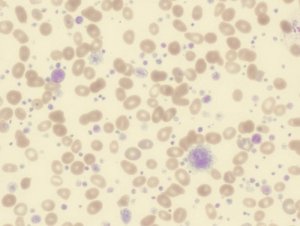Thrombocytosis: Symptoms, Causes, and Treatment


Reviewed and approved by the doctor Leonardo Biolatto
Thrombocytosis is a disease that’s characterized by a considerable increase in blood platelets. The normal platelet count is between 150,000 and 450,000 per microliter of blood. If it is slightly above or below, it’s still normal. If they exceed that range by a lot, doctors consider it thrombocytosis.
Cells called megakaryocytes produce platelets in the bone marrow. They play an important role in blood clotting, which is necessary to stop bleeding. Therefore, experts consider thrombocytosis a bone marrow and blood disease.
Too many platelets in the body can lead to serious health problems, such as heart attack or stroke, among others.
Types of thrombocytosis
Basically, there are two types of thrombocytosis: primary, or essential, and secondary. In essential thrombocytosis, the marrow produces abnormal platelets and its cause is unknown. Secondary thrombocytosis, on the other hand, is a consequence of other diseases such as infections, cancer, anemia, etc.
Read this article too: Deep Vein Thrombosis: How to Detect and Prevent It
Another way to classify thrombocytosis is into three groups: congenital, acquired, and pseudo thrombocytosis. Congenital is passed on by a pattern of inheritance and is present at birth. Acquired thrombocytosis, meanwhile, is divided into two groups:
- Primary: This classification corresponds to essential thrombocytosis. It’s caused by genetic mutations. In many cases, the reason why the disease occurs is unknown.
- Secondary or reactive: This is a consequence of other diseases. It’s the most common, as it corresponds to 85% of cases. More than half of them are due to infections.
Pseudothrombocytosis, meanwhile, corresponds to cases of false positives. There are circumstances in which the person analyzing the cytoplasmic fragments confuses them with platelets which gives rise to a misdiagnosis.
Symptoms
In most cases, the disease does not produce any symptoms. It’s usually detected accidentally when a blood count is performed.
However, when the disease is primary or essential, sometimes there are symptoms such as head or chest pain, dizziness, weakness, loss of vision or seeing spots. Fatigue, night sweats, and weight loss are also common. The suspicion increases if, also, there is a history of spontaneous abortions in the first trimester of pregnancy, splenomegaly or enlargement of the spleen, bleeding or hypertension.
It’s also characteristic that there is erythromelalgia in essential thrombocytosis. This is vasodilation in the arteries of the hands and feet that causes an increased temperature in the extremities, as well as itching, pain, and erythema.
You may also enjoy this article: Nine Foods that May Help Reduce Your Risk of Thrombosis and Stroke
Causes of thrombocytosis
Overall, most current research indicates that an acquired somatic mutation causes essential thrombocytosis. Therefore, it’s not inherited. In 50% of cases, there is a mutation of the JAK2 gene. In another important number of cases, there’s a mutation of the CARL gene. Also, cases of mutations in the MPL, THPO, and TET2 genes have been found.
Several of these genes are responsible for making proteins. These have an important impact on the division of blood cells and, in particular, platelets. Overall, experts believe that the mutation produces the symptoms in essential thrombocytosis. However, they still don’t know how that process is carried out.
Also, there are many cases in which they cannot detect a mutation. Therefore, the cause of the primary form of the disease is completely unknown. As for the secondary form, it’s typically due to underlying diseases.
Treatment
Essential thrombocytosis does not require treatment, as long as it remains stable and there are no signs or symptoms of the disease. Sometimes, doctors may recommend taking aspirin daily. This is to prevent the formation of blood clots.
However, if the patient has a history or risk of cardiovascular disease, it’s most likely that their doctor will prescribe medications to decrease platelet counts. This is also advisable if the patient is over 60 years old or if the platelet count is greater than one million.
In the case of the secondary type of this disease, the treatment consists in controlling the disease that causes thrombocytosis. In emergencies, a specialist will carry out the procedure thrombocytopheresis or plateletpheresis. This consists of a blood filtrate that’s similar to dialysis.
All cited sources were thoroughly reviewed by our team to ensure their quality, reliability, currency, and validity. The bibliography of this article was considered reliable and of academic or scientific accuracy.
- Fernández, C. M., Castillo, J. P. M., García, P. G., de Julián, E. C., & Bieler, C. B. (2008, July). Trombocitosis en la consulta de oncohematología. Descripción, diagnóstico etiológico y evolución. In Anales de Pediatría (Vol. 69, No. 1, pp. 10-14). Elsevier Doyma.
- Carrillo-Esper, R., Garnica-Escamilla, M., & Ramírez-Rosillo, F. (2013). Trombocitosis. Rev Invest Med Sur Mex.
- Badell, I., Torrent, M., & López, E. (2006). Alteraciones plaquetarias: Trombopenias y trombocitosis. Anales de Pediatria Continuada. https://doi.org/10.1016/S1696-2818(06)73584-3
This text is provided for informational purposes only and does not replace consultation with a professional. If in doubt, consult your specialist.








